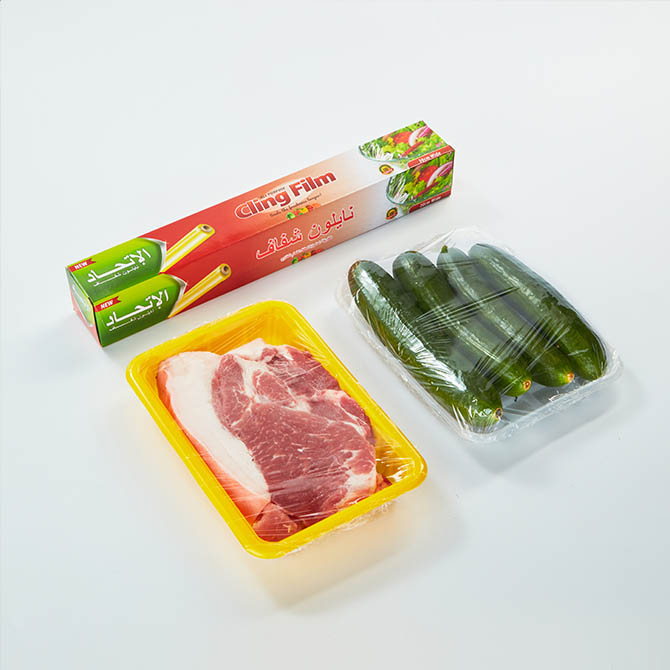Catering Film Wrap is a thin, flexible plastic film used primarily for wrapping and preserving food items. It is designed to cling tightly to food surfaces, creating a barrier against moisture, air, and contaminants. This clingy nature is what distinguishes it from other packaging options, such as food foil and traditional plastic wraps.

There are several types of catering film wraps available in the market, each with unique properties:
PVC Film Wrap: This type is commonly used in the food industry due to its excellent clarity and cling properties. It is ideal for wrapping sandwiches, fruits, and other food items.
PE Film Wrap: Made from polyethylene, this wrap is food-safe and often used in households. While it may not cling as tightly as PVC, it is more environmentally friendly.
Biodegradable Film Wrap: As sustainability becomes increasingly important, biodegradable options are gaining popularity. These wraps maintain the same functionality as traditional films but decompose more easily.
Applications of Catering Film Wrap
Catering film wrap is versatile and can be used in various settings, including:
Catering Services: Keeping food fresh during transportation and serving.
Restaurants: Protecting prepared dishes in the kitchen or while stored in the fridge.
Households: Covering leftovers, wrapping snacks, or preparing meals in advance.
Benefits of Using Catering Film Wrap
Freshness Preservation: One of the primary advantages of catering film wrap is its ability to keep food fresh. By reducing exposure to air, it helps prevent spoilage and extends the shelf life of food items.
Hygiene and Safety: Cling film acts as a barrier against contaminants, ensuring that food remains safe for consumption. This is particularly crucial in catering, where food safety standards are stringent.
Convenience: Catering film wrap is lightweight and easy to use, making it a convenient choice for busy kitchens and catering operations. It can be torn easily and adheres well to various surfaces.
Versatility: It can be used for a wide range of food items, from fruits and vegetables to prepared meals and baked goods. This versatility makes it an essential tool in any kitchen.
Cost-Effectiveness: Catering film wrap is relatively inexpensive, making it an economical choice for businesses that require large quantities of food packaging.
Comparison with Other Food Packaging Materials
While catering film wrap offers numerous benefits, it is important to compare it with other food packaging materials such as food foil and packaging Saran Wrap.
Food Foil
Food foil, or aluminum foil, is often used in food service for wrapping items that require heat retention or protection from light. Here are some comparisons:
Heat Resistance: Food foil can withstand higher temperatures, making it suitable for baking and roasting. In contrast, catering film wrap is not microwave-safe and should not be used for cooking.
Moisture Barrier: Aluminum foil provides an excellent barrier against moisture and air, making it ideal for long-term storage.
Reusability: Food foil can be reused, while cling wrap is typically single-use.
Packaging Saran Wrap
Packaging saran wrap is another term commonly used for cling film. It shares many similarities with catering film wrap, but here are a few distinctions:
Material: Saran wrap is generally made from PVC and has excellent cling properties, similar to catering film wrap.
Environmental Impact: Many brands of saran wrap are not biodegradable, raising concerns about environmental sustainability.
Best Practices for Using Catering Film Wrap
To maximize the effectiveness of catering film wrap, consider the following best practices:
Clean Surfaces: Always ensure that the surfaces you are wrapping are clean and dry to achieve the best cling and prevent contamination.
Avoid Overlapping: When wrapping, avoid overlapping too much to ensure a tight seal that keeps air out.
Store Properly: Keep unused rolls of cling film in a cool, dry place to maintain their quality.
Check for Safety: Ensure that the film is labeled as food-safe and suitable for your intended use.
Environmental Considerations
As with many plastic products, the environmental impact of catering film wrap is a growing concern. While it offers numerous benefits in food preservation and safety, the disposal of plastic wrap poses challenges.
Sustainable Alternatives
To mitigate the environmental impact, consider using:
Biodegradable Wraps: These wraps break down more easily and are better for the environment.
Reusable Food Storage Containers: Investing in high-quality, reusable containers can reduce reliance on single-use wraps.
Beeswax Wraps: An eco-friendly alternative, beeswax wraps can be used multiple times and are biodegradable.
Conclusion
Catering film wrap is an indispensable tool in the food service industry, providing excellent preservation, hygiene, and convenience. Its ability to cling tightly to food surfaces helps maintain freshness and safety, making it a preferred choice for catering services, restaurants, and households alike. While it is essential to consider the environmental impact of plastic wraps, sustainable alternatives are emerging to address these concerns.
By understanding the various applications and benefits of catering film wrap, food service professionals can enhance their packaging strategies, ensuring that their offerings remain fresh and appealing to customers. Whether it's Food Cling Wrap, packaging saran wrap, or food foil, each material serves a unique purpose in the culinary world, contributing to the overall success of food preservation and presentation.
